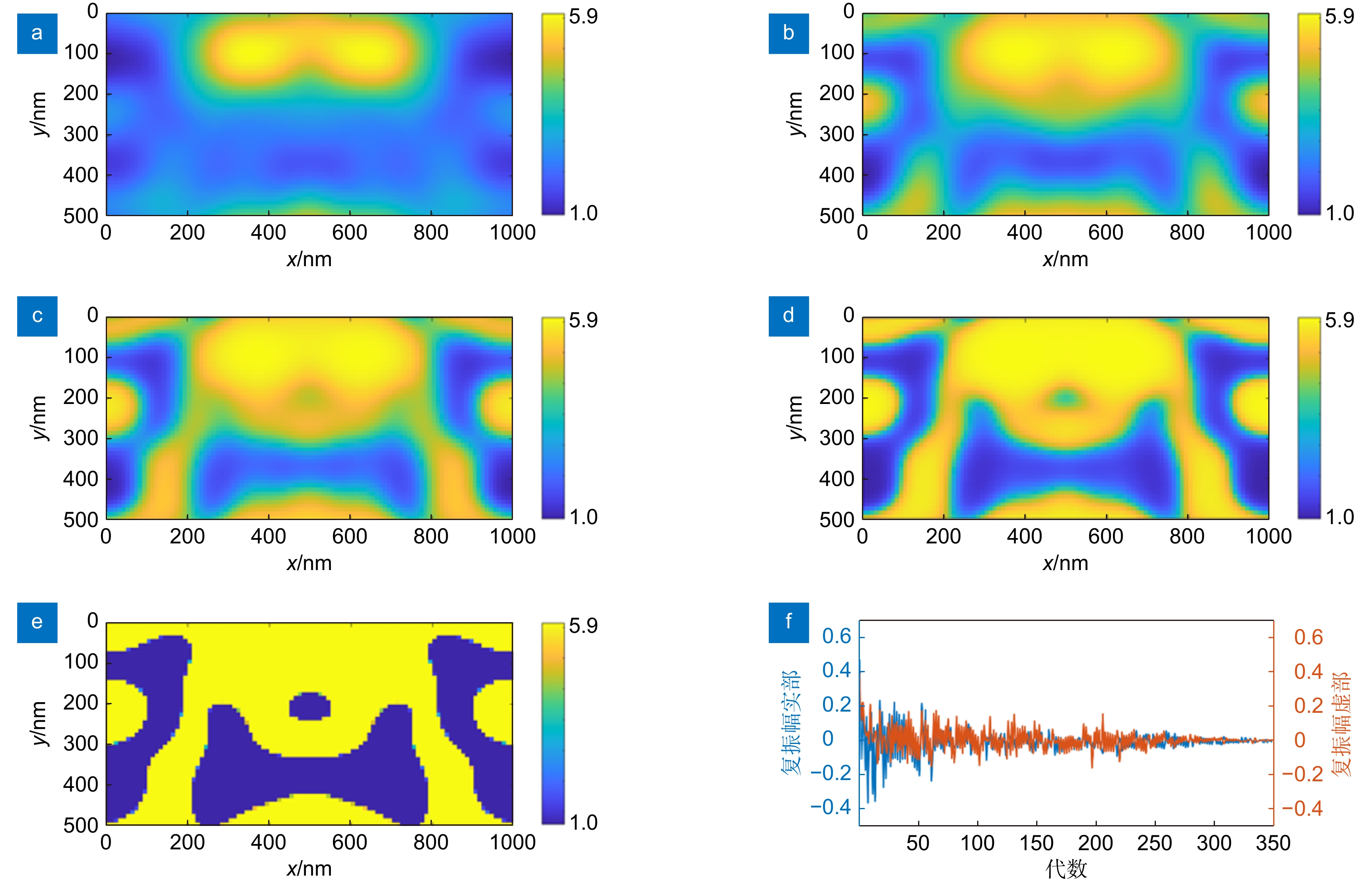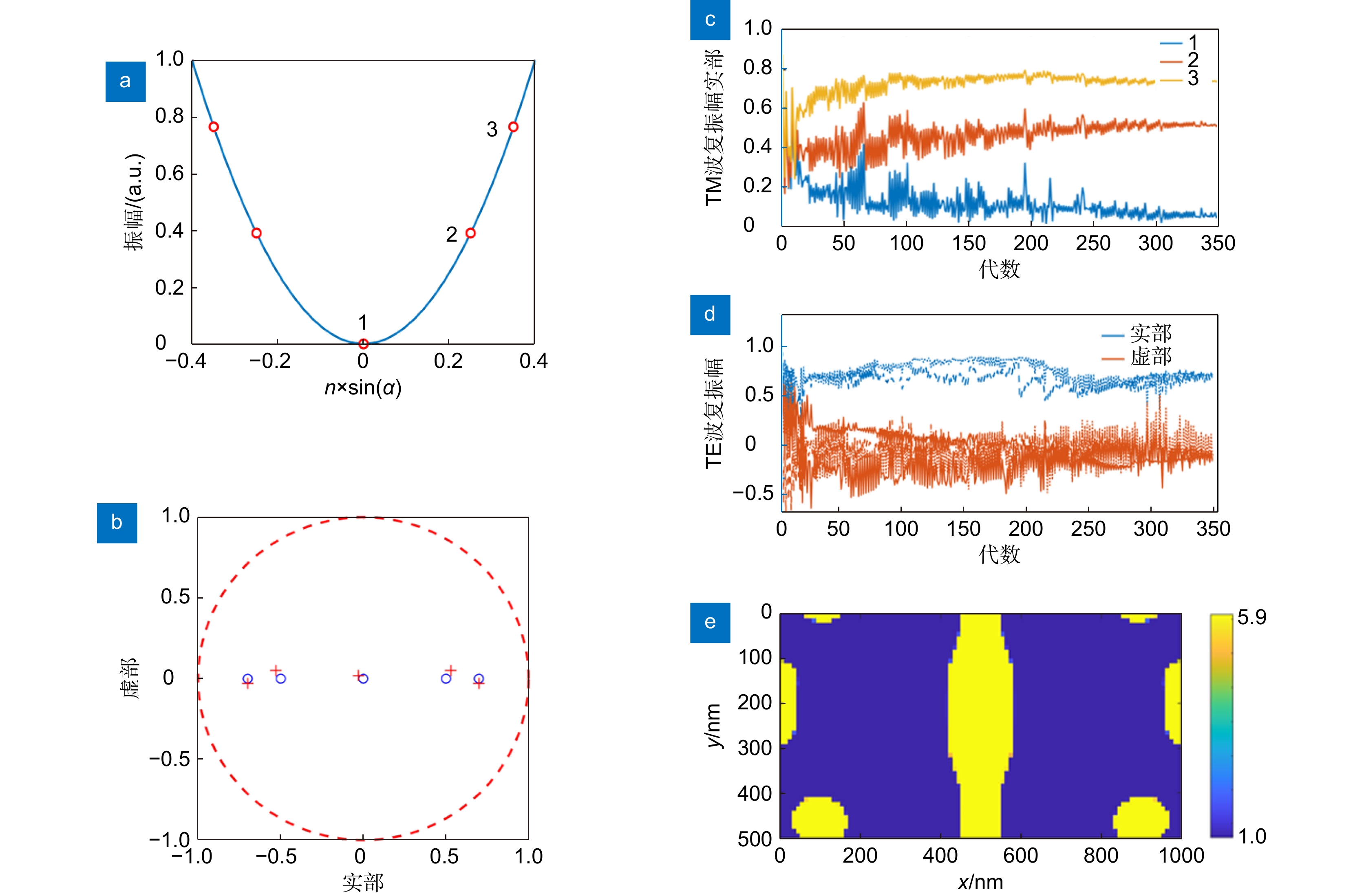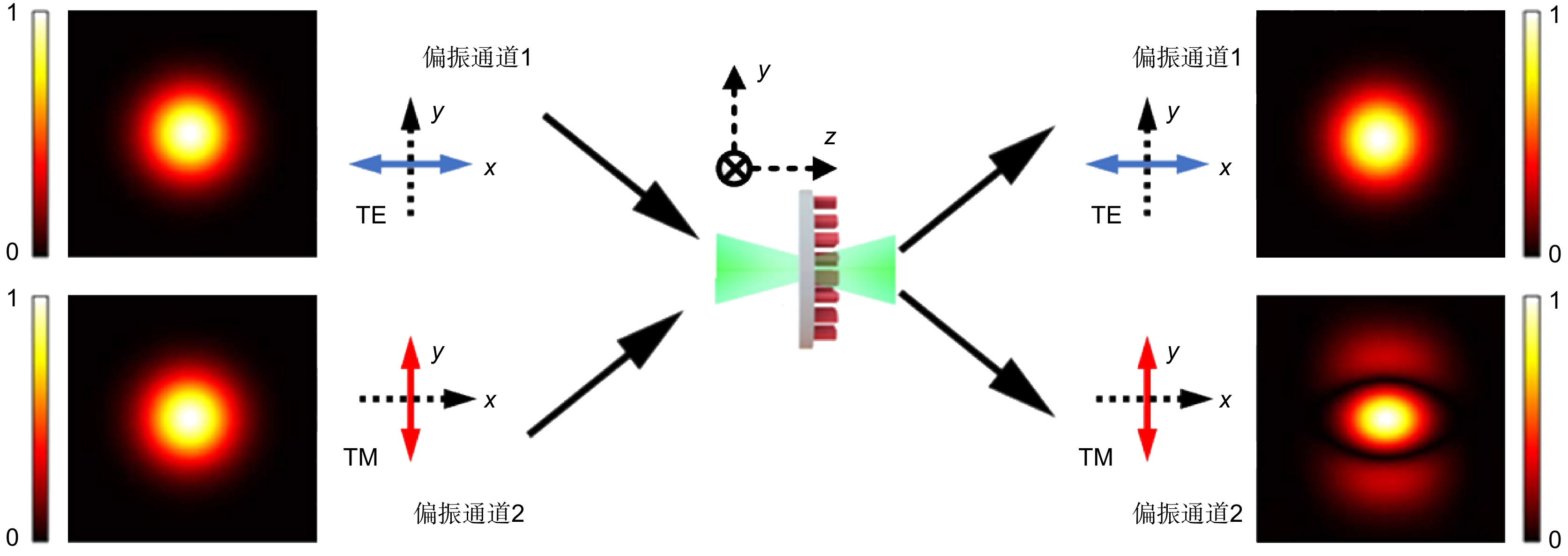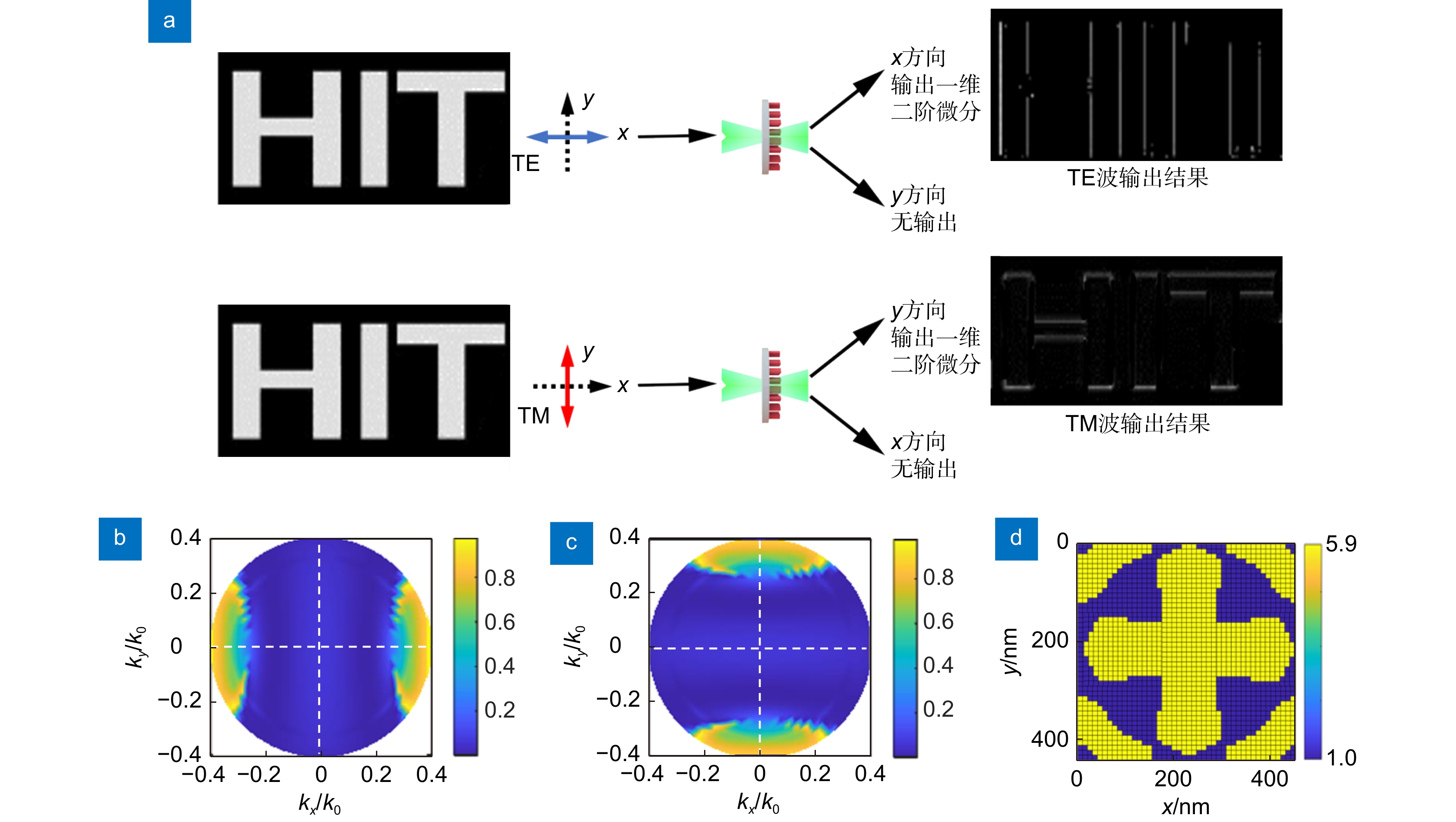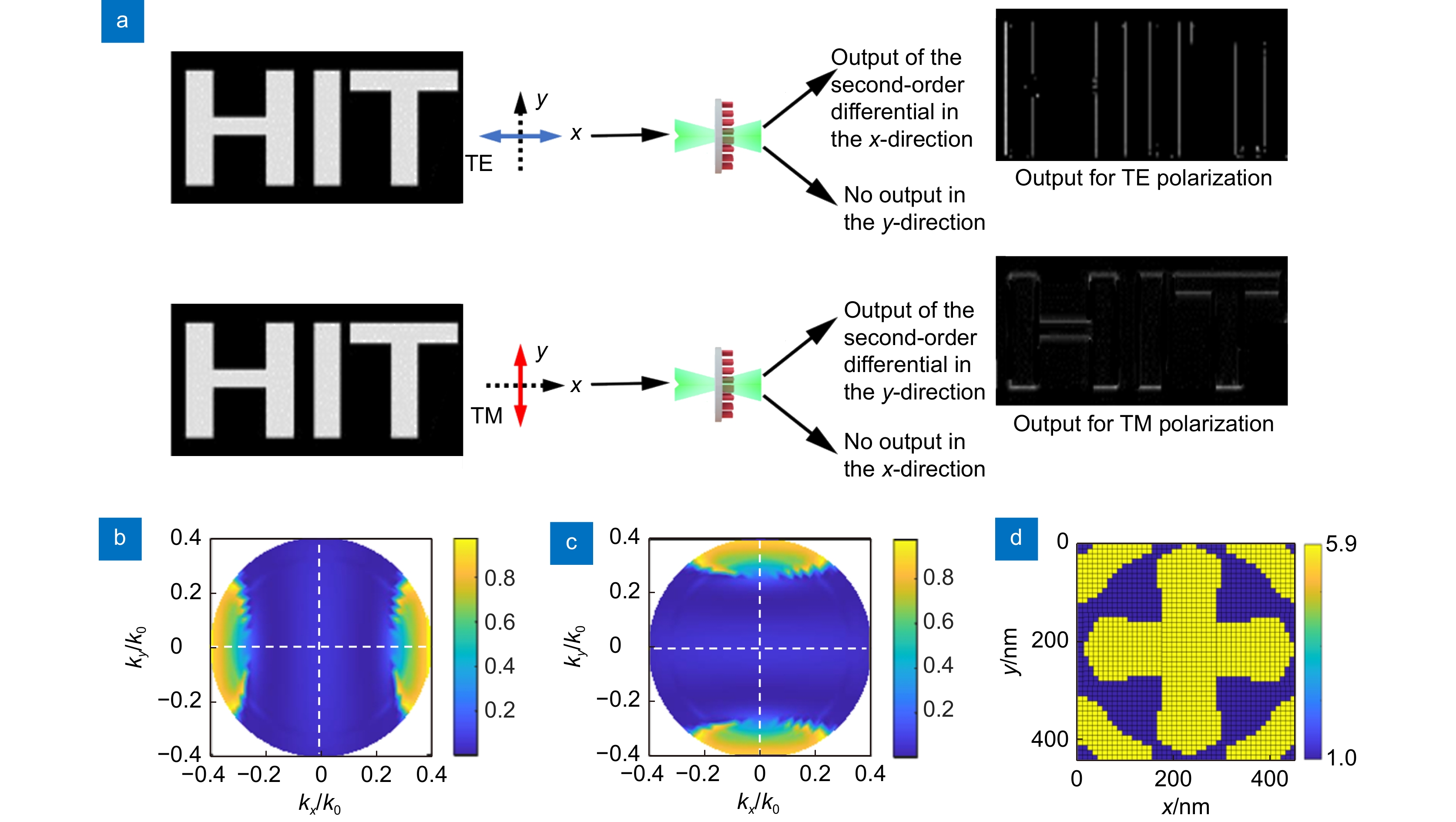-
摘要:
光学模拟计算通过在空间域直接对光学输入进行调控,避免了各种应用场景中光电之间的转换。因此在图像处理等应用领域成为人们研究的重点。本文用拓扑优化方法设计了一类利用格林函数法的偏振复用光学模拟计算超表面结构。在不同线偏振光入射下,该拓扑优化超表面可以独立地对透射光场的振幅和相位进行调控。实现了在正交偏振态下,分别呈现明场成像与一维二阶微分运算,以及偏振控制微分方向的复用微分系统。这种偏振复用的设计可以在更多的光学计算应用场景中发挥重要作用。
Abstract:Optical analog computing avoids the photoelectric conversion in various application scenarios by directly modulating the optical input in the spatial domain. Therefore, it has become a research focus in many applications such as image processing. In this paper, a polarization-multiplexed optical analog computing metasurface structure based on the Green's function method is designed using topologal optimization. Under different linearly polarized light incidence, this topological metasurface can independently tailor the amplitude and phase of the transmitted light field. It achieves bright-field imaging and one-dimensional second-order differentiation operations in orthogonal polarization states, as well as a polarization- controlled differentiation direction for a multiplexed differential system. These polarization-multiplexed designs can play a vital role in more optical computing application scenarios.
-
Overview: With the continuous development of information technology, the requirements for signal processing in various application scenarios have become higher and higher, and the data capacity has also shown explosive growth. The processing of large amounts of data has become a worldwide problem. However, existing electronic technologies have limitations in terms of speed and power consumption, making it difficult to achieve real-time, high-throughput signal processing. In recent years, with the image spatial differentiation playing an increasingly important role in signal processing and other application fields, and the continuous advancement of micro-nano processing technology, optical analog computing has attracted much attention. It avoids the photoelectric conversion in various application scenarios by directly modulating the optical input in the spatial domain. There are two distinct approaches to realize the optical analog computing, one is based on the 4F optical systems, while the other is metasurface structures based on the Green's function method. Among them, the recently developed dielectric metasurfaces can realize various mathematical operations of optical signals, such as differentiation and integration, and has become one of the most interesting scientific and engineering topics. This paper presents the design of polarization-multiplexed optical analog computing metasurfaces based on the Green's function method. Numerical simulations using the Finite-Difference Time-Domain (FDTD) method were conducted to investigate the performance of the designed metasurfaces. The final single-layer metasurface structure is entirely binary after topological optimization, which can be constructed using titanium dioxide (TiO2) and air. Under different linearly polarized light incidences, this topological metasurface can independently tailor the amplitude and phase of the transmitted light field to achieve spatial optical differentiation functionalities. Two polarization-multiplexed dual-function analog computing metasurfaces were simulated and verified with the computational results meeting the expected design theory. One of them achieves bright-field imaging and one-dimensional second-order differentiation operations in orthogonal polarization states. The other design is a multiplexed differential system that can control the second-order differentiation operation direction in accordance with different orthogonal linear polarization states. For TE-polarized incidence, one-dimensional second-order differentiation is achieved in the x-direction, with no transmission in the y-direction. For TM-polarized incidence, one-dimensional second-order differentiation occurs in the y-direction, with no transmission in the x-direction, enabling the extraction of edge information in different directions for the orthogonal polarization states. These polarization- multiplexed designs can play a role in more optical computing application scenarios.
-

-
图 1 (a) 偏振复用光学模拟计算系统示意图,TE和TM不同偏振输入会输出不同运算结果;(b) 单个优化目标在复振幅平面的值;(c) 伴随优化流程图
Figure 1. (a) Schematic of polarization-multiplexed optical analog computing systems. The different inputs of TE and TM polarization will output different operation results; (b) The values of the individual optimization target on the complex amplitude plane; (c) The flowchart of the adjoint optimization
图 2 (a)-(e) 正入射时超表面的拓扑优化过程,拓扑优化后最终超表面结构完全二值化。图中colorbar表示超表面的介电常数分布情况;(f) 正入射时TM偏振的单点复振幅按目标0+0i进行的拓扑优化结果
Figure 2. (a)-(e) The topological optimization process of metasurfaces for normal incidence. The final metasurface structure is completely binary after topological optimization. The colorbars represent the dielectric constant distribution of the metasurfaces; (f) The topological optimization results for TM polarization at normal incidence with a single-point target of 0+0i
图 3 (a) TM偏振入射时多目标优化选取的目标点;(b) 1、2、3三点TM偏振入射时在复振幅平面上的优化结果;(c) 1、2、3三点TM偏振入射的优化过程;(d) 1、2、3三点TE偏振入射的优化过程;(e) 拓扑优化后超表面的介电常数分布
Figure 3. (a) The selected target points of multi-objective optimization for TM polarization; (b) Optimization results on the complex amplitude plane for TM polarization at points 1, 2, and 3; (c) Optimization process for TM polarization at points 1, 2, and 3; (d) Optimization process for TE polarization at points 1, 2, and 3; (e) The dielectric constant distribution of the metasurface after topological optimization
图 5 (a) 偏振控制微分方向示意图。TE和TM不同偏振入射光经超表面调控后会在正交偏振方向分别实现微分运算;(b) TE偏振的振幅传递函数;(c) TM偏振的振幅传递函数;(d) 拓扑优化后的偏振复用超表面结构。图中colorbar表示超表面的介电常数分布情况
Figure 5. (a) Schematic of polarization-controlled differentiation direction. The different input light of TE and TM polarization will achieve differentiation operations in orthogonal polarization direction, respectively; (b) The amplitude transfer function for TE polarization; (c) The amplitude transfer function for TM polarization; (d) The polarization-multiplexed metasurface structure after topological optimization. The colorbar represents the dielectric constant distribution of the metasurface
-
[1] Zhou Y, Zheng H Y, Kravchenko I I, et al. Flat optics for image differentiation[J]. Nat Photonics, 2020, 14(5): 316−323. doi: 10.1038/s41566-020-0591-3
[2] Silva A, Monticone F, Castaldi G, et al. Performing mathematical operations with metamaterials[J]. Science, 2014, 343(6167): 160−163. doi: 10.1126/science.1242818
[3] Xu C Y, Wang Y L, Zhang C, et al. Optical spatiotemporal differentiator using a bilayer plasmonic grating[J]. Opt Lett, 2021, 46(17): 4418−4421. doi: 10.1364/OL.436033
[4] He Y L, Xie Z Q, Yang B, et al. Controllable photonic spin Hall effect with phase function construction[J]. Photonics Res, 2020, 8(6): 963−971. doi: 10.1364/PRJ.388838
[5] Yang W J, Yu X Y, Zhang J L, et al. Plasmonic transmitted optical differentiator based on the subwavelength gold gratings[J]. Opt Lett, 2020, 45(8): 2295−2298. doi: 10.1364/OL.390566
[6] Zhu T F, Zhou Y H, Lou Y J, et al. Plasmonic computing of spatial differentiation[J]. Nat Commun, 2017, 8: 15391. doi: 10.1038/ncomms15391
[7] Kulishov M, Azaña J. Long-period fiber gratings as ultrafast optical differentiators[J]. Opt Lett, 2005, 30(20): 2700−2702. doi: 10.1364/OL.30.002700
[8] Liu F F, Wang T, Qiang L, et al. Compact optical temporal differentiator based on silicon microring resonator[J]. Opt Express, 2008, 16(20): 15880−15886. doi: 10.1364/OE.16.015880
[9] Huang T L, Zheng A L, Dong J J, et al. Terahertz-bandwidth photonic temporal differentiator based on a silicon-on-isolator directional coupler[J]. Opt Lett, 2015, 40(23): 5614−5617. doi: 10.1364/OL.40.005614
[10] Yan S Q, Cheng Z W, Frandsen L H, et al. Bandwidth-adaptable silicon photonic differentiator employing a slow light effect[J]. Opt Lett, 2017, 42(8): 1596−1599. doi: 10.1364/OL.42.001596
[11] Ngo N Q. Design of an optical temporal integrator based on a phase-shifted fiber Bragg grating in transmission[J]. Opt Lett, 2007, 32(20): 3020−3022. doi: 10.1364/OL.32.003020
[12] Ferrera M, Park Y, Razzari L, et al. On-chip CMOS-compatible all-optical integrator[J]. Nat Commun, 2010, 1(1): 29. doi: 10.1038/ncomms1028
[13] Zangeneh-Nejad F, Khavasi A. Spatial integration by a dielectric slab and its planar graphene-based counterpart[J]. Opt Lett, 2017, 42(10): 1954−1957. doi: 10.1364/OL.42.001954
[14] Wang X, Zhou F, Yan S Q, et al. Broadband on-chip integrator based on silicon photonic phase-shifted Bragg grating[J]. Photonics Res, 2017, 5(3): 182−186. doi: 10.1364/PRJ.5.000182
[15] Kwon H, Sounas D, Cordaro A, et al. Nonlocal metasurfaces for optical signal processing[J]. Phys Rev Lett, 2018, 121(17): 173004. doi: 10.1103/PhysRevLett.121.173004
[16] Woods D, Naughton T J. Photonic neural networks[J]. Nat Phys, 2012, 8(4): 257−259. doi: 10.1038/nphys2283
[17] Wu C M, Yu H S, Lee S, et al. Programmable phase-change metasurfaces on waveguides for multimode photonic convolutional neural network[J]. Nat Commun, 2021, 12(1): 96. doi: 10.1038/s41467-020-20365-z
[18] Shen Y C, Harris N C, Skirlo S, et al. Deep learning with coherent nanophotonic circuits[J]. Nat Photonics, 2017, 11(7): 441−446. doi: 10.1038/nphoton.2017.93
[19] Huo P C, Zhang C, Zhu W Q, et al. Photonic spin-multiplexing metasurface for switchable spiral phase contrast imaging[J]. Nano Lett, 2020, 20(4): 2791−2798. doi: 10.1021/acs.nanolett.0c00471
[20] He Q, Zhang F, Pu M B, et al. Monolithic metasurface spatial differentiator enabled by asymmetric photonic spin-orbit interactions[J]. Nanophotonics, 2021, 10(1): 741−748. doi: 10.1515/nanoph-2020-0366
[21] Gao H, Fan X, Wang Y, et al. Multi-foci metalens for spectra and polarization ellipticity recognition and reconstruction[J]. Opto-Electron Sci, 2023, 2: 220026. doi: 10.29026/oes.2023.220026
[22] Khonina S N, Kazanskiy N L, Butt M A, et al. Optical multiplexing techniques and their marriage for on-chip and optical fiber communication: a review[J]. Opto-Electron Adv, 2022, 5: 210127. doi: 10.29026/oea.2022.210127
[23] Liu Y M, Zhang X. Metamaterials: a new frontier of science and technology[J]. Chem Soc Rev, 2011, 40(5): 2494−2507. doi: 10.1039/c0cs00184h
[24] Liu W W, Li Z C, Li Z, et al. Energy-tailorable spin-selective multifunctional metasurfaces with full fourier components[J]. Adv Mater, 2019, 31(32): 1901729. doi: 10.1002/adma.201901729
[25] Feng H, Li Q T, Wan W P, et al. Spin-switched three-dimensional full-color scenes based on a dielectric meta-hologram[J]. ACS Photonics, 2019, 6(11): 2910−2916. doi: 10.1021/acsphotonics.9b01017
[26] Fan Q, Zhu W Q, Liang Y Z, et al. Broadband generation of photonic spin-controlled arbitrary accelerating light beams in the visible[J]. Nano Lett, 2018, 19(2): 1158−1165. doi: 10.1021/acs.nanolett.8b04571
[27] Huang K, Deng J, Leong H S, et al. Ultraviolet Metasurfaces of≈80% Efficiency with Antiferromagnetic Resonances for Optical Vectorial Anti-Counterfeiting[J]. Laser Photonics Rev, 2019, 13(5): 1800289. doi: 10.1002/lpor.201800289
[28] Zhang C, Divitt S, Fan Q B, et al. Low-loss metasurface optics down to the deep ultraviolet region[J]. Light Sci Appl, 2020, 9: 55. doi: 10.1038/s41377-020-0287-y
[29] Wesemann L, Rickett J, Song J C, et al. Nanophotonics enhanced coverslip for phase imaging in biology[J]. Light Sci Appl, 2021, 10(1): 98. doi: 10.1038/s41377-021-00540-7
[30] Zhu T F, Guo C, Huang J Y, et al. Topological optical differentiator[J]. Nat Commun, 2021, 12(1): 680. doi: 10.1038/s41467-021-20972-4
[31] Long O Y, Guo C, Wang H W, et al. Isotropic topological second-order spatial differentiator operating in transmission mode[J]. Opt Lett, 2021, 46(13): 3247−3250. doi: 10.1364/OL.430699
[32] Ruan Z C. Spatial mode control of surface Plasmon polariton excitation with gain medium: from spatial differentiator to integrator[J]. Opt Lett, 2015, 40(4): 601−604. doi: 10.1364/OL.40.000601
[33] Liu M Z, Zhu W Q, Huo P C, et al. Multifunctional metasurfaces enabled by simultaneous and independent control of phase and amplitude for orthogonal polarization states[J]. Light Sci Appl, 2021, 10: 107. doi: 10.1038/s41377-021-00552-3
[34] Fan Q B, Liu M Z, Zhang C, et al. Independent amplitude control of arbitrary orthogonal states of polarization via dielectric metasurfaces[J]. Phys Rev Lett, 2020, 125(26): 267402. doi: 10.1103/PhysRevLett.125.267402
[35] Zhang F, Pu M B, Li X, et al. All-dielectric metasurfaces for simultaneous giant circular asymmetric transmission and wavefront shaping based on asymmetric photonic spin-orbit interactions[J]. Adv Funct Mater, 2017, 27: 1704295. doi: 10.1002/adfm.201704295
[36] Miller O. Photonic design: from fundamental solar cell physics to computational inverse design[D]. Berkeley: University of California, 2012.
-


 E-mail Alert
E-mail Alert RSS
RSS
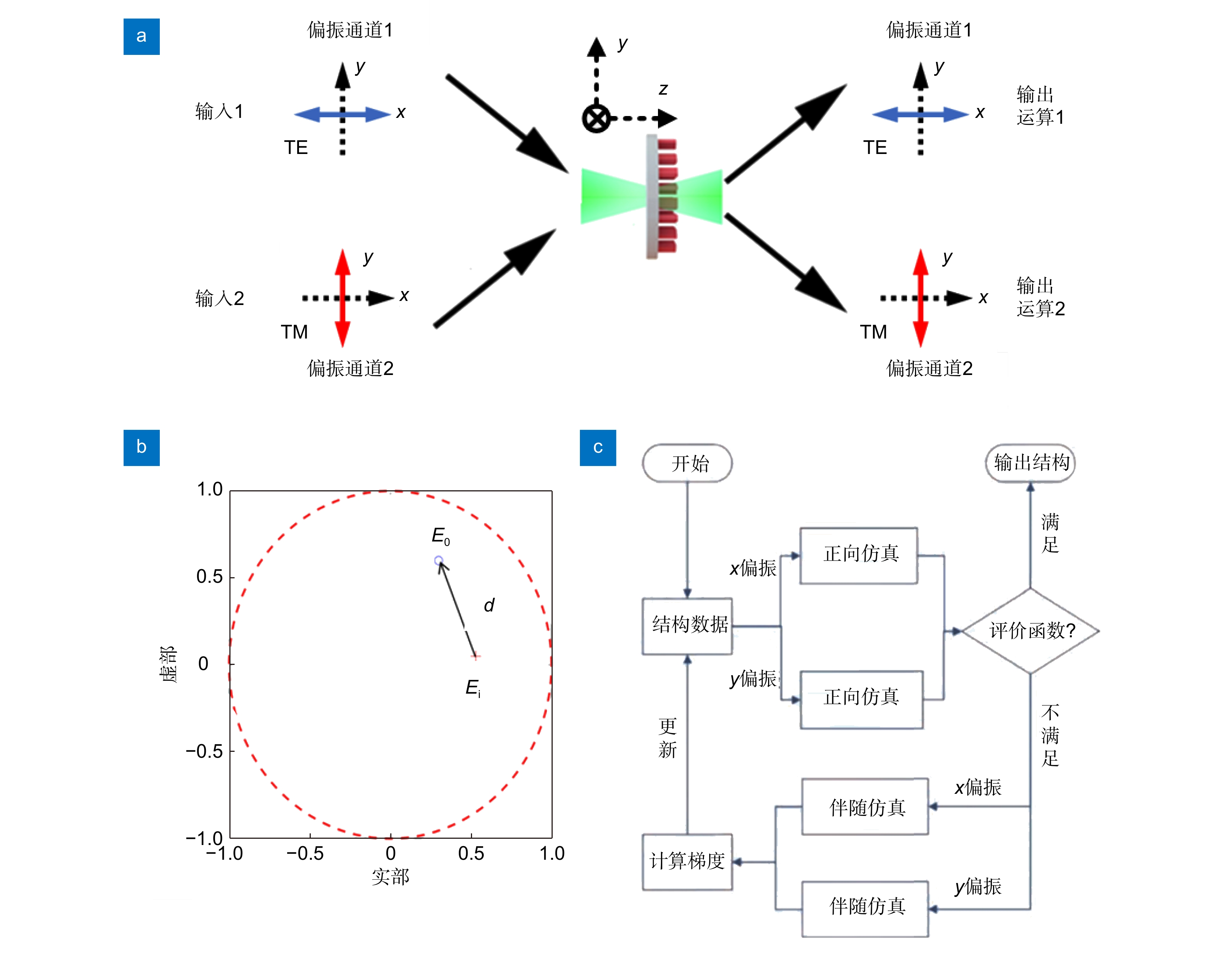
 下载:
下载:
